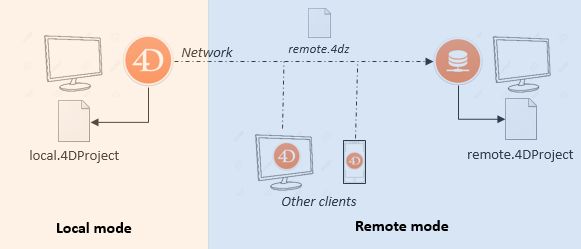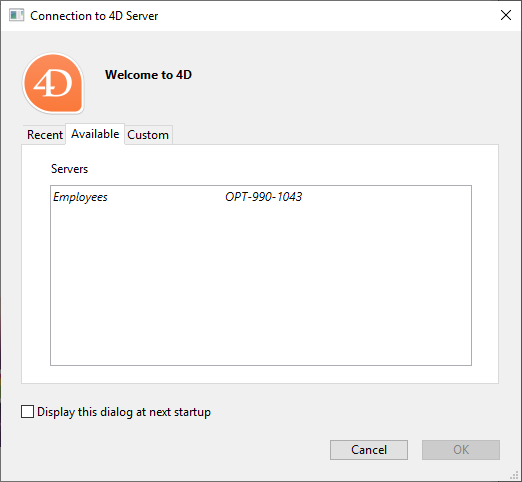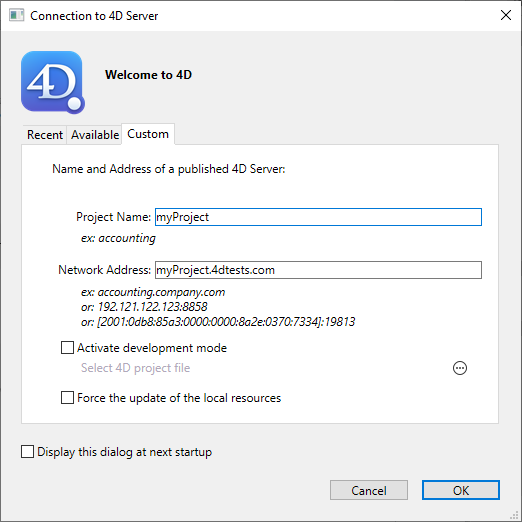Client/Server Management
4D Desktop applications can be used in a Client/Server configuration, either as merged client/server applications or as remote projects.
-
merged client/server applications are generated by the Build Application manager. They are used for application deployments.
-
remote projects are .4DProject files opened by 4D Server and accessed with 4D in remote mode. The server sends a .4dz version of the project (compressed format) to the remote 4D, thus structure files are read-only. This configuration is usually used for application testing.

Connecting to a remote project from the same machine as 4D Server allows modifying the project files. This specific feature allows to develop a client/server application in the same context as the deployment context.
Opening a merged client/server application
A merged client/server application is customized and its starting is simplified:
- To launch the server portion, the user simply double-clicks on the server application. The project file does not need to be selected.
- To launch the client portion, the user simply double-clicks the client application, which connects directly to the server application.
These principles are detailed in the Build Application page.
Opening a remote project
The first time you connect to a 4D Server project via a remote 4D, you will usually use the standard connection dialog. Thereafter, you will be able to connect directly using the Open Recent Projects menu or a 4DLink shortcut file.
To connect remotely to a 4D Server project:
- Do one of the following:
- Select Connect to 4D Server in the Welcome Wizard dialog
- Select Open/Remote Project... from the File menu or the Open toolbar button.
The 4D Server connection dialog appears. This dialog has three tabs: Recent, Available, and Custom.
If 4D Server is connected to the same subnetwork as the remote 4D, select Available. 4D Server includes a built-in broadcasting system that, by default, publishes the name of the 4D Server projects available over the network. The list is sorted by order of appearance and updated dynamically.

To connect to a server from the list, double-click on its name or select it and click the OK button.
If the published project is not displayed in the Available list, select Custom. The Custom page allows you to connect to a published server on the network using its network address and assigning it a customized name.

- Project name: Defines the local name of the 4D Server project. This name will be used in the Recent page when referring to the project.
- Network address: The IP address of the machine where the 4D Server was launched.
- If two servers are executed simultaneously on the same machine, the IP address must be followed by a colon and port number, for example:
192.168.92.104:19814. - By default, the publishing port of a 4D Server is 19813. This number can be modified in the Project settings.
- If two servers are executed simultaneously on the same machine, the IP address must be followed by a colon and port number, for example:
The Activate development mode option opens the remote connection in a special read/write mode and requires to access the project folder from the remote 4D (compatibility option).
Once this page assigns a server, clicking the OK button will allow you to connect to the server.
Once a connection to the server has been established, the remote project will be listed on the Recent tab.
Updating project files on the server
4D Server automatically creates and sends the remote machines a .4dz version of the .4DProject project file (not compressed) in interpreted mode.
- An updated .4dz version of the project is automatically produced when necessary, i.e. when the project has been modified and reloaded by 4D Server. The project is reloaded:
- automatically, when the 4D Server application window comes to the front of the OS or when the 4D application on the same machine saves a modification (see below).
- when the
RELOAD PROJECTcommand is executed. Calling this command is necessary for example when you have pulled a new version of the project from the source control platform.
Updating project files on remote machines
When an updated .4dz version of the project has been produced on 4D Server, connected remote 4D machines must log out and reconnect to 4D Server in order to benefit from the updated version.
Using 4D and 4D Server on the same machine
When 4D connects to a 4D Server on the same machine, the application behaves as 4D in single user mode and the design environment allows you to edit project files. This feature allows you to develop a client/server application in the same context as the deployment context.
When 4D connects to a 4D Server on the same machine, the development mode is automatically activated, whatever the Activate development mode option status.
Each time 4D performs a Save all action from the design environment (explicitly from File menu or implicitly by switching to application mode for example), 4D Server synchronously reloads project files. 4D waits for 4D Server to finish reloading the project files before it continues.
However, you need to pay attention to the following behavior differences compared to standard project architecture:
- the userPreferences.{username} folder used by 4D is not the same folder used by 4D Server in the project folder. Instead, it is a dedicated folder, named "userPreferences", stored in the project system folder (i.e., the same location as when opening a .4dz project).
- the folder used by 4D for derived data is not the folder named "DerivedData" in the project folder. Instead it is a dedicated folder named "DerivedDataRemote" located in the project system folder.
- the catalog.4DCatalog file is not edited by 4D but by 4D Server. Catalog information is synchronised using client/server requests
- the directory.json file is not edited by 4D but by 4D Server. Directory information is synchronised using client/server requests
- 4D uses its own internal components and plug-ins instead of those in 4D Server.
It is not recommended to install plug-ins or components at the 4D or 4D Server application level.
Remote user sessions
On the server, the Session command returns a session object describing the current user session. This object is handled through the functions and properties of the Session class.
Usage
The session object allows you to handle information and privileges for the remote user session.
You can share data between all processes of the user session using the session.storage shared object. For example, you can launch a user authentication and verification procedure when a client connects to the server, involving entering a code sent by e-mail or SMS into the application. You then add the user information to the session storage, enabling the server to identify the user. This way, the 4D server can access user information for all client processes, enabling customized code to be written according to the user's role.
You can also assign privileges to a remote user session to control access when the session comes from Qodly pages running in web areas.
Availability
The remote user session object is available from:
- Project methods that have the Execute on Server attribute (they are executed in the "twinned" process of the client process),
- Triggers,
- ORDA data model functions (except those declared with the
localkeyword, On Server Open ConnectionandOn Server Shutdown Connectiondatabase methods.
All stored procedures on the server share the same virtual user session. For more information, see this page on doc.4d.com.
Sharing the session with Qodly pages in Web areas
Remote client sessions can be used to handle Client/Server applications where Qodly pages are used for the interface, running on remote machines. With this configuration, your applications have modern CSS-based web interfaces but still benefit from the power and simplicity of integrated client/server development. In such applications, Qodly pages are executed within standard 4D Web areas.
To manage this configuration, you need to use remote client sessions. Actually, requests coming from both the remote 4D application and its Qodly pages loaded in Web areas need to work inside a single user session. You just have to share the same session between the remote client and its web pages so that you can have the same session storage and client license, whatever the request origin.
Note that privileges should be set in the session before executing a web request from a Web area, so that the user automatically gets their privileges for web access (see example). Keep in mind that privileges only apply to requests coming from the web, not to the 4D code executed in a standard remote session.
Shared sessions are handled through OTP tokens. After you created an OTP token on the server for the user session, you add the token (through the $4DSID parameter value) to web requests sent from web areas containing Qodly pages so that the user session on the server is identified and shared. On the web server side, if a web request contains an OTP id in the $4DSID parameter, the session corresponding to this OTP token is used.
Example
var $otp : Text
// Some privileges are put in the remote user session on the server for a further web access
ds.resetPrivileges("basic")
// An OTP is created on the server for this remote client session
$otp:=ds.getOTP()
// The user has already the required privileges for a web access
// and the same session is shared between this remote user and the web Qodly app
WA OPEN URL(*; "Welcome"; "http://127.0.0.1/$lib/renderer/?w=People&$4DSID="+$otp)
resetPrivileges() function in the Datastore class:
// This function is run on the server
// and puts some privileges in the session for a further web access
Function resetPrivileges($priv : Text)
Session.clearPrivileges()
Session.setPrivileges($priv)
getOTP() function in the Datastore class:
// This function is run on the server
// and generates an OTP able to retrieve this remote user session
Function getOTP(): Text
return Session.createOTP()